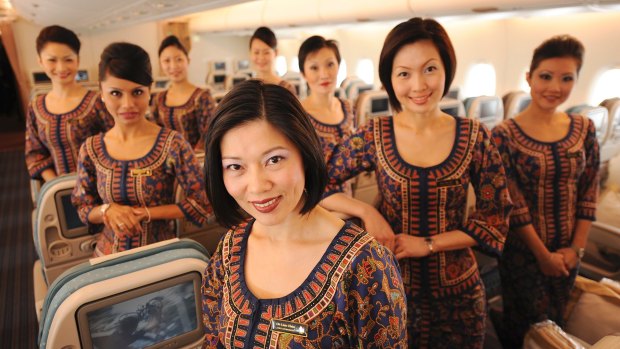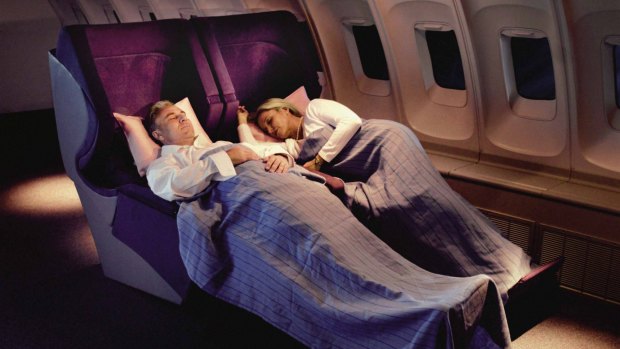This was published 7 years ago
Singapore Airlines' 50th anniversary: The airline that changed a nation
By Steve Meacham
Fifty years ago, on Thursday, April 6, 1967, The Sydney Morning Herald carried a brief news story headlined "Air Service to Malaysia".
The story gave no indication of the technological and commercial revolution that was about to happen.
In fact, it's hard to imagine three more bland sentences (or a less accurate four-word headline since the destination airport, Singapore, by then was no longer part of Malaysia).

Singapore Airlines' flight attendants have become iconic.Credit: Joe Armao
"The first Malaysia-Singapore Airlines service between Sydney and Singapore left Sydney yesterday," the story began.
"The new service will fly to Singapore, by way of Djakarta (sic), and will call at Perth on its southbound flight to Sydney.
"A Qantas jet, chartered by Malaysia-Singapore Airlines, will operate the weekly Singapore-Sydney flight both ways."

New-age travel: Singapore Airlines' new business class spacebed.
But please forgive the Herald editors for their lack of foresight. It was a crowded news day.
The main photo on the front page on April 6, 1967, was of a shoeless and cross-legged Australian Prime Minister Harold Holt being given a cotton wrist band "to ward off evil spirits and bring good luck" by his Laotian equivalent during his official visit to the capital, Vientiane. (Warning: a Laotian good luck charm obviously isn't waterproof – Holt went for a swim in wild surf that December, and was never seen again, prompting countless conspiracy theories.)
The Herald's lead story reported that the NSW Premier Sir Robert Askin (later proven to be among the most corrupt politicians to ever reach high office in Australia – and that's a big race field) was quoted as vehemently denying his Commissioner of Police had been bribed.
So why focus on this relatively obscure 50th anniversary?
Because it's a salutary reminder of how significantly air travel has changed Australia's place in the world.
Few other countries – with the notable exception of New Zealand and the Pacific nations – have been changed more emphatically by the invention of the jet engine than Australia. The Tyranny of Distance – a term first popularised by historian Geoffrey Blainey in his book published the same year MSA was created – is now more of A Minor Inconvenience of Distance.
Qantas' Sydney to Dallas flight (13,804 kilometres) used to be the world's longest commercial flight until 2017 when Qatar started direct flights from Doha to Auckland (14,535 kilometres).
See also: Tips on surviving the world's longest flight from the pilot
But now the race is on to become the first airline that can fly nonstop the equivalent of 17,150 kilometres – the distance from Sydney to London.
If technology continues at its current pace, we'll see that in our lifetimes. But instead of trying to forecast how humans will be "flying" in 2067, let's examine how far we've come in the past half century.
On the birthday next Wednesday, 36 "SQ" – as Singapore Airlines flights are labelled – will arrive and depart from Australian airports, capable of carrying a total of 10,470 passengers.
Both Singapore Airlines (SIA) and Malaysia Airlines date their involvement with Australia from those first "MSA" flights using a DH Comet which carried a total of 70 passengers – 20 in first class and 50 in economy.
MSA was born in 1966, a year after Singapore declared independence from the Federation of Malaysia. Yet the situation between the two countries was still amicable enough then for the two governments to acquire majority takes in the renamed Malaysian Airways to launch an international service – to Manila in 1966, then Perth and Taipei in 1967. (MSA was the fifth international airline to enter the Perth market after Qantas, British Airways, South African Airways and Air India.)
Sydney was initially served via Perth, but in the spring of 1967 a more direct flight on a Boeing B707-320B fanjet was added to Singapore via Jakarta, meaning there were up to four flights a week between Sydney and Singapore.
But though the flight time between Perth and Singapore (around five hours 10 minutes on an Airbus A333 or Boeing B772) is much the same 50 years later because the DH Comet was so technologically advanced for its era, the present average journey time between Sydney and Singapore (approximately seven hours 40 minutes on an Airbus A388 or Boeing B77W) bears no relationship to the journey times in 1967 which required lengthy stops in Perth or Jakarta.
By 1971 – the same year MSA announced three return flights a week to Melbourne – the two governments announced a split. In future there would be two separate national airlines – Singapore and Malaysia.
"It was a different world in 1967," explains Geoffrey Thomas, editor-in-chief of AirlineRatings.com, the world's premier airline safety and product rating website.
"Back then, Australia was served by a handful of mainly government-run airlines.
"Qantas, British Airways, Air New Zealand but also Lufthansa, KLM, Air Italia, UTA (now part of Air France), and Pan Am were all here before MSA.
"Most of those don't fly here any more. Those still might operate a code share arrangement, but you won't see their planes on an Australian runway.
"Essentially what happened is that MSA – and Singapore and Malaysia after 1971 – plus Cathay Pacific (which began flying between Hong Kong and Australia in 1970) led a revolution of lower cost travel, with more frills and better service."
Our conversation is necessarily brief because – ironically – Thomas is in an airport lounge, heading to Melbourne for an airline function.
"In 1967, the average weekly wage in Australia was $60," Thomas says. "It would take the average Australian 28 weeks to purchase a return fare from Sydney to London.
"In 2017, the average wage in Australia is $1575 a week. If you multiply that by 28 you could now buy the following return tickets to London: four first-class tickets; seven business tickets; 12 premium economy tickets; and 28 economy tickets.
"That means you could take 27 of your closest friends to London and back for what it would have cost you for the equivalent of one return fare in 1967."
See also: Why overseas flights from Australia are cheaper than ever
Thomas explains that there has been "a dramatic revolution in air travel over the past five decades". And that's all to do with improvements in engine technology and computer technology "which has made airline travel affordable for most Australians".
SIA's direct flights from Sydney, Melbourne, Brisbane and Adelaide will cruise at 35,000 feet (10,668 metres) at an average speed of 550mp/h (885km/h).
See also: Sky high - the reason planes fly at 35,000 feet
Sure, the flight might seem interminable. But whichever class you've paid for you can bring your own electronic devices and work in the air if you want to, watch the inflight movies on your personal screen, devour the latest series of your favourite TV franchise, or occupy yourself with online games and a swathe of audio channels. (More than 1000 options, and you can check what's available before you fly at singaporeair.com_UK/au.flying-withus/entertainment.)
Cast yourself back 50 years ago, and what did you get in MSA's economy cabin in 1967?
You would have had more legroom. But your inflight entertainment would have been a good book or an out-of-focus video screen showing a heavily censored "new release".
"In 1967, airlines could probably have done the trip between Sydney and London in three stops," Thomas says. "But they often stopped more often to suit government affiliations. It was a very dysfunctional airline network with many stops – very inefficient and very time consuming."
Hang on. Wasn't this the so-called "Golden Age" of air travel?
"Yes, this was the era of 'the Jet Set', Thomas concedes. "But because it was so expensive to fly, the clientele was very well-heeled. MSA was the first airline to offer free drinks in the economy cabin. MSA and Singapore led the way."
Giants of the airline industry have crashed and burned (metaphorically) since then. Pan Am, TWA, Braniff and our own Ansett Australia are now just memories, replaced by the likes of Virgin Australia, Jetstar and other low-cost carriers.
Malaysia Airlines, the other half of MSA, clearly had a horror year in 2014 with the disappearance of MH370 en route to Beijing and the shooting down of MH17 over Ukraine as it flew from Amsterdam to Kuala Lumpur (with 38 Australians among the victims). Yet, like SIA, Malaysia has continued to fly to and from Australia for half a century.
Clearly those airlines which are based here, or across the Tasman, tend to have the most flights to and from Australia.
But SIA, with its famous golden bird logo, is still among the leading operators both in terms of reputation and number of flights (125 will leave Australia in the week of the anniversary).
And no other uniform in world aviation is more instantly recognisable or more timeless than the signature sarong kebaya that have been worn by generations of "Singapore Girls" since 1968.
Designed by the famous Parisian couturier Pierre Balmain, the batiq outfits come in four colours – blue (stewardess), green (leading stewardess), red (chief stewardess) and purple (inflight supervisor).
Who knows what technological changes in aviation will come in the next half century. But let's hope the Singapore Girl will still be gracing the skies above Australia for many years to come.
TIMELINE
APRIL 1967 Malaysia-Singapore Airlines flies for the first time to Perth and Sydney.
APRIL 1971 Singapore Airlines (SIA) flies for the first time to Melbourne.
MAY 1976 Launches twice-weekly B707 service to Auckland via Sydney.
MARCH 1984 Introduces weekly service to Brisbane and Adelaide.
OCTOBER 2007 SIA becomes first international airline to take ownership of the new Airbus, A380. Its first commercial flight – SQ380 – arrives in Sydney on October 25.
SEPTEMBER 2016 Launches its Capital Route from Singapore – Canberra – Wellington, becoming the first airline to operate international flights between the capitals of Singapore, Australia and New Zealand.
See also: Airline review: Singapore Airlines A350 business class
See also: Airline review: Singapore Airlines premium economy class
SIA flies from Sydney, Brisbane, Perth, Melbourne, Adelaide and Canberra to Singapore, with connections to 102 destinations in 34 countries across its global network, which includes its regional wing Silk Air that flies from Darwin and Cairns to Singapore.
PARTNER
Since 2012, SIA has partnered with Virgin Australia allowing passengers to fly from any of Virgin's 49 airports in regional Australia with seamless connections (including baggage check) on to Singapore.
Passengers travelling on Virgin with a ticket issued by SIA can enjoy complimentary meals and beverages regardless of which cabin they are flying in.
The two airlines were also the first in the world to allow their KrisFlyer and Velocity frequent flyer members to convert miles and points between programs.
Sign up for the Traveller Deals newsletter
Get exclusive travel deals delivered straight to your inbox. Sign up now.